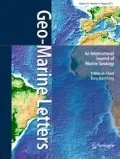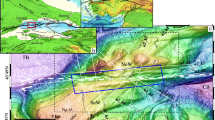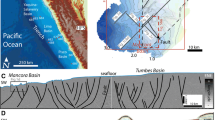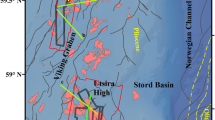Abstract
A growing number of studies on shallow marine gas/fluid systems from across the globe indicate their abundance throughout geological epochs. However, these episodic events have not been fully integrated into the fundamental concepts of continental margin development, which are thought to be dictated by three elements: tectonics, sedimentation and eustasy. The current study focuses on the passive sector of the Levant Basin on the eastern Mediterranean continental margin where these elements are well constrained, in order to isolate the contribution of gas/fluid systems. Single-channel, multichannel and 3D seismic reflection data are interpreted in terms of variance, chaos, envelope and sweetness attributes. Correlation with the Romi-1 borehole and sequence boundaries constrains interpretation of seismic stratigraphy. Results show a variety of fluid- or gas-related features such as seafloor and subsurface pockmarks, volumes of acoustic blanking, bright spots, conic pinnacle mounds, gas chimneys and high sweetness zones that represent possible secondary reservoirs. It is suggested that gas/fluid migrate upwards along lithological conduits such as falling-stage systems tracts and sequence boundaries during both highstands and lowstands. In all, 13 mid-late Pleistocene sequence boundaries are accompanied by independent evidence of 13 eustatic sea-level drops. Whether this connection is coincidental or not requires further research. These findings fill gaps between previously reported sporadic appearances throughout the Levant Basin and margin and throughout geological time from the Messinian until the present day, and create a unified framework for understanding the system as a whole. Repetitive appearance of these features suggests that their role in the morphodynamics of continental margins is more important than previously thought and thus may constitute one of the key elements of continental margin development.









Similar content being viewed by others
References
Almogi-Labin A, Buchbinder B, Siman-Tov R, Grossowicz L, Eshet Y, Rosenfeld A (2001) Stratigraphic and environmental analysis of the Romi-1 borehole, offshore Israel. Geological Survey of Israel, Jerusalem
Avnaim-Katav S, Almogi-Labin A, Sandler A, Sivan D, Porat N, Matmon A (2012) The chronostratigraphy of a quaternary sequence at the distal part of the nile littoral cell, Haifa Bay, Israel. J Quat Sci 27:675–686. doi:10.1002/jqs.2537
Bard E, Hamelin B, Fairbanks RG, Zindler A (1990) Calibration of the 14-C timescale over the past 30,000 years using mass spectrometric U-Th ages from Barbados corals. Nature 345:405–409
Ben-Gai Y, Ben-Avraham Z, Buchbinder B, Kendall CGSC (2005) Post-Messinian evolution of the Southeastern Levant Basin based on two-dimensional stratigraphic simulation. Mar Geol 221:359–379
Bertoni C, Cartwright J, Hermanrud C (2013) Evidence for large-scale methane venting due to rapid drawdown of sea level during the Messinian Salinity Crisis. Geology 41:371–374
Biddle KT, Wielchowsky CC (1994) Hydrocarbon traps. Chapter 13: part III. Processes. In: Magoor LB, Dow WG (eds) The petroleum system from source to trap. Am Assoc Petrol Geosci Memoirs 60:219–235
Bowman SA (2011) Regional seismic interpretation of the hydrocarbon prospectivity of offshore Syria. GeoArabia 16:95–124
Camerlenghi A, Cita M, Della Vedova B, Fusi N, Mirabile L, Pellis G (1995) Geophysical evidence of mud diapirism on the Mediterranean Ridge accretionary complex. Mar Geophys Res 17:115–141
Catuneanu O (2002) Sequence stratigraphy of clastic systems: concepts, merits, and pitfalls. J Afr Earth Sci 35:1–43. doi:10.1016/s0899-5362(02)00004-0
Catuneanu O (2006) Principles of sequence stratigraphy. Elsevier, Holland
Coleman DF, Ballard RD (2001) A highly concentrated region of cold hydrocarbon seeps in the southeastern Mediterranean Sea. Geo-Mar Lett 21:162–167. doi:10.1007/s003670100079
Dimitrov L (2002) Mud volcanoes - The most important pathway for degassing deeply buried sediments. Earth-Sci Rev 59:49–76
Dimitrov L, Woodside J (2003) Deep sea pockmark environments in the eastern Mediterranean. Mar Geol 195:263–276
Duggen S, Hoernle K, Van Den Bogaard P, Rüpke L, Morgan JP (2003) Deep roots of the Messinian salinity crisis. Nature 422:602–606
Dupré S, Woodside J, Foucher J-P, de Lange G, Mascle J, Boetius A, Mastalerz V, Stadnitskaia A, Ondréas H, Huguen C et al (2007) Seafloor geological studies above active gas chimneys off Egypt (Central Nile Deep Sea Fan). Deep Sea Res I Oceanogr Res Pap 54:1146–1172
Dupré S, Woodside J, Klaucke I, Mascle J, Foucher J-P (2010) Widespread active seepage activity on the Nile Deep Sea Fan (offshore Egypt) revealed by high-definition geophysical imagery. Mar Geol 275:1–19
Dupré S, Mascle J, Foucher J-P, Harmegnies F, Woodside J, Pierre C (2014) Warm brine lakes in craters of active mud volcanoes, Menes caldera off NW Egypt: evidence for deep-rooted thermogenic processes. Geo-Mar Lett 34:153–168. doi:10.1007/s00367-014-0367-1
Eruteya OE, Waldmann N, Schalev D, Makovsky Y, Ben-Avraham Z (2015) Intra- to post-Messinian deep-water gas piping in the Levant Basin, SE Mediterranean. Mar Pet Geol 66:246–261
Fairbanks R (1989) A 17,000-year glacio-eustatic sea level record: influence of glacial melting rates on the Younger Dryas event and deep-ocean circulation. Nature 342:637–642
Feinstein S, Aizenshtat Z, Miloslavski I, Gerling P, Slager J, McQuilken J (2002) Genetic characterization of gas shows in the east Mediterranean offshore of southwestern Israel. Org Geochem 33:1401–1413. doi:10.1016/s0146-6380(02)00184-5
Feseker T, Brown KR, Blanchet C, Scholz F, Nuzzo M, Reitz A, Schmidt M, Hensen C (2010) Active mud volcanoes on the upper slope of the western Nile deep-sea fan—first results from the P362/2 cruise of R/V Poseidon. Geo-Mar Lett 30:169–186. doi:10.1007/s00367-010-0192-0
Foucher J-P, Dupré S, Scalabrin C, Feseker T, Harmegnies F, Nouzé H (2010) Changes in seabed morphology, mud temperature and free gas venting at the Håkon Mosby mud volcano, offshore northern Norway, over the time period 2003–2006. Geo-Mar Lett 30:157–167. doi:10.1007/s00367-010-0193-z
Garcia-Castellanos D, Estrada F, Jiménez-Munt I, Gorini C, Fernández M, Vergés J, De Vicente R (2009) Catastrophic flood of the Mediterranean after the Messinian salinity crisis. Nature 462:778–781
Gardosh M, Druckman Y, Buchbinder B, Calvo R (2008) The Oligo-Miocene deepwater system of the Levant Basin. Geological Survey of Israel, Jerusalem
Gargani J, Rigollet C (2007) Mediterranean Sea level variations during the Messinian salinity crisis. Geophys Res Lett 34, L10405. doi:10.1029/2007GL029885
Halbouty MT (1972) Rationale for deliberate pursuit of stratigraphic, unconformity, and paleogeomorphic traps. Am Assoc Petrol Geol Spec Publ 10:3–7
Haq B (1998) Natural gas hydrates: searching for the long-term climatic and slope-stability records. Geol Soc Lond Spec Publ 137:303–318
Hart B (2008) Channel detection in 3-D seismic data using sweetness. Am Assoc Pet Geol Bull 92:733–742
Hunt D, Tucker ME (1992) Stranded parasequences and the forced regressive wedge systems tract: deposition during base-level fall. Sed Geol 81:1–9
Judd AG (2003) The global importance and context of methane escape from the seabed. Geo-Mar Lett 23:147–154. doi:10.1007/s00367-003-0136-z
Just J, Hübscher C, Betzler C, Lüdmann T, Reicherter K (2011) Erosion of continental margins in the Western Mediterranean due to sea-level stagnancy during the Messinian Salinity Crisis. Geo-Mar Lett 31:51–64. doi:10.1007/s00367-010-0213-z
Krijgsman W, Hilgen F, Raffi I, Sierro F, Wilson D (1999) Chronology, causes and progression of the Messinian salinity crisis. Nature 400:652–655
Lafuerza S, Sultan N, Canals M, Frigola J, Berne S, Jouet G, Galavazi M, Sierro F (2009) Overpressure within upper continental slope sediments from CPTU data, Gulf of Lion, NW Mediterranean Sea. Int J Earth Sci 98:751–768
Lazar M, Schattner U, Reshef M (2012) The great escape: an intra-Messinian gas system in the eastern Mediterranean. Geophys Res Lett 39, L20309. doi:10.1029/2012GL053484
Lee HJ, Locat J, Desgagnés P, Parsons JD, McAdoo BG, Orange DL, Puig P, Wong FL, Dartnell P, Boulanger E (2007) Submarine mass movements on continental margins. In: Nittrouer CA, Austin JA, Field ME, Kravitz JH, Syvitski JPM, Wilberg PL (eds) Continental margin sedimentation: from sediment transport to sequence stratigraphy. Blackwell, Oxford, pp 213–274
León R, Somoza L, Medialdea T, González FJ, Díaz-del-Río V, Fernández-Puga MC, Maestro A, Mata MP (2007) Sea-floor features related to hydrocarbon seeps in deepwater carbonate-mud mounds of the Gulf of Cádiz: from mud flows to carbonate precipitates. Geo-Mar Lett 27:237–247. doi:10.1007/s00367-007-0074-2
León R, Somoza L, Medialdea T, González FJ, Gimenez-Moreno CJ, Pérez-López R (2014) Pockmarks on either side of the Strait of Gibraltar: formation from overpressured shallow contourite gas reservoirs and internal wave action during the last glacial sea-level lowstand? Geo-Mar Lett 34:131–151. doi:10.1007/s00367-014-0358-2
Loncke L, Mascle J, Fanil Scientific Parties (2004) Mud volcanoes, gas chimneys, pockmarks and mounds in the Nile deep-sea fan (Eastern Mediterranean): geophysical evidences. Mar Pet Geol 21:669–689
Loncke L, Gaullier V, Droz L, Ducassou E, Migeon S, Mascle J (2009) Multi-scale slope instabilities along the Nile deep-sea fan, Egyptian margin: a general overview. Mar Pet Geol 26:633–646
Luyendyk B, Kennett J, Clark JF (2005) Hypothesis for increased atmospheric methane input from hydrocarbon seeps on exposed continental shelves during glacial low sea level. Mar Pet Geol 22:591–596
Lykousis V, Alexandri S, Woodside J, de Lange G, Dählmann A, Perissoratis C, Heeschen K, Ioakim C, Sakellariou D, Nomikou P, Rousakis G, Casas D, Ballas D, Ercilla G (2009) Mud volcanoes and gas hydrates in the Anaximander mountains (Eastern Mediterranean Sea). Mar Pet Geol 26:854–872. doi:10.1016/j.marpetgeo.2008.05.002
Macgregor DS (2012) The development of the Nile drainage system: integration of onshore and offshore evidence. Pet Geosci 18:417–431
Marfurt KJ, Kirlin RL, Farmer SL, Bahorich MS (1998) 3-D seismic attributes using a semblance-based coherency algorithm. Geophysics 63:1150–1165
Mascle J, Mary F, Praeg D, Brosolo L, Camera L, Ceramicola S, Dupré S (2014) Distribution and geological control of mud volcanoes and other fluid/free gas seepage features in the Mediterranean Sea and nearby Gulf of Cadiz. Geo-Mar Lett 34:89–110. doi:10.1007/s00367-014-0356-4
Maslin M, Owen M, Day S, Long D (2004) Linking continental-slope failures and climate change: testing the clathrate gun hypothesis. Geology 32:53–56
Miller KG, Mountain GS, Wright JD, Browning JV (2011) Sea level and ice volume variations. Oceanography 24:40–53
Mitchum RM Jr, Vail PR, Sangree JB (1977) Seismic stratigraphy and global changes of sea level. Part 6. Stratigraphic interpretation of seismic reflection patterns in depositional sequences. AAPG Memoir 26:117–133
Nisbet E (1990) The end of the ice age. Can J Earth Sci 27:148–157
Norris RD, Röhl U (1999) Carbon cycling and chronology of climate warming during the Palaeocene/Eocene transition. Nature 401:775–778
Owen M, Day S, Maslin M (2007) Late Pleistocene submarine mass movements: occurrence and causes. Quat Sci Rev 26:958–978
Pape T, Kasten S, Zabel M, Bahr A, Abegg F, Hohnberg H-J, Bohrmann G (2010) Gas hydrates in shallow deposits of the Amsterdam mud volcano, Anaximander Mountains, Northeastern Mediterranean Sea. Geo-Mar Lett 30:187–206. doi:10.1007/s00367-010-0197-8
Pilcher R, Argent J (2007) Mega-pockmarks and linear pockmark trains on the West African continental margin. Mar Geol 244:15–32
Plaza-Faverola A, Bünz S, Mienert J (2011) Repeated fluid expulsion through sub-seabed chimneys offshore Norway in response to glacial cycles. Earth Planet Sci Lett 305:297–308
Posamentier HW, Allen GP (1999) Siliciclastic sequence stratigraphy: concepts and applications. SEPM Concepts in Sedimentology and Paleontology, Tulsa, OK
Riboulot V, Cattaneo A, Sultan N, Garziglia S, Ker S, Imbert P, Voisset M (2013) Sea-level change and free gas occurrence influencing a submarine landslide and pockmark formation and distribution in deepwater Nigeria. Earth Planet Sci Lett 375:78–91
Riboulot V, Thomas Y, Berné S, Jouet G, Cattaneo A (2014) Control of Quaternary sea level changes on gas seeps. Geophys Res Lett 41:4970–4977
Rollet N, Logan G, Kennard J, O’Brien P, Jones A, Sexton M (2006) Characterisation and correlation of active hydrocarbon seepage using geophysical data sets: an example from the tropical, carbonate Yampi Shelf, Northwest Australia. Mar Pet Geol 23:145–164
Roveri M, Flecker R, Krijgsman W, Lofi J, Lugli S, Manzi V, Sierro FJ, Bertini A, Camerlenghi A, de Lange G (2014) The Messinian Salinity Crisis: past and future of a great challenge for marine sciences. Mar Geol 352:25–58
Sandler A, Herut B (2000) Composition of clays along the continental shelf off Israel: contribution of the Nile versus local sources. Mar Geol 167:339–354
Schattner U, Lazar M, Tibor G, Ben-Avraham Z, Makovsky Y (2010) Filling up the shelf—A sedimentary response to the last post-glacial sea rise. Mar Geol 278:165–176
Schattner U, Lazar M, Harari D, Waldmann N (2012) Active gas migration systems offshore northern Israel, first evidence from seafloor and subsurface data. Cont Shelf Res 48:167–172
Schroot BM, Klaver GT, Schüttenhelm RT (2005) Surface and subsurface expressions of gas seepage to the seabed—examples from the Southern North Sea. Mar Pet Geol 22:499–515
Sela-Adler M, Herut B, Bar-Or I, Antler G, Eliani-Russak E, Levy E, Makovsky Y, Sivan O (2015) Geochemical evidence for biogenic methane production and consumption in the shallow sediments of the SE Mediterranean shelf (Israel). Cont Shelf Res 101:117–124
Suc J-P, Do Couto D, Melinte-Dobrinescu MC, Macaleţ R, Quillévéré F, Clauzon G, Csato I, Rubino J-L, Popescu S-M (2011) The Messinian salinity crisis in the Dacic Basin (SW Romania) and early Zanclean Mediterranean–Eastern Paratethys high sea-level connection. Palaeogeogr Palaeoclimatol Palaeoecol 310:256–272
Sultan N, Marsset B, Ker S, Marsset T, Voisset M, Vernant A-M, Bayon G, Cauquil E, Adamy J, Colliat J (2010) Hydrate dissolution as a potential mechanism for pockmark formation in the Niger delta. J Geophys Res Solid Earth 115, B08101. doi:10.1029/2010JB007453
Tibor G, Ben-Avraham Z (1992) Late Tertiary seismic facies and structures of the Levant passive margin off central Israel, eastern Mediterranean. Mar Geol 105:253–273
Toyos MH, Medialdea T, León R, Somoza L, González FJ, Meléndez N (2016) Evidence of episodic long-lived eruptions in the Yuma, Ginsburg, Jesús Baraza and Tasyo mud volcanoes, Gulf of Cádiz. Geo-Mar Lett 36. doi:10.1007/s00367-016-0440-z
Vail P, Mitchum R Jr, Thompson S III (1977) Seismic stratigraphy and global changes of sea level: part 4. Global cycles of relative changes of sea level: section 2. Application of seismic reflection configuration to stratigraphic interpretation. AAPG Spec 165:83–97
Vail PR, Audemard F, Bowman SA, Eisner PN, Perez-Cruz C (1991) The stratigraphic signatures of tectonics, eustasy and sedimentology - an overview. In: Einsele G, Ricken W, Seilacher W (eds) Cycles and events in stratigraphy. Springer, Berlin, pp 617–659
Woodside JM, Volgin AV (1996) Brine pools associated with Mediterranean Ridge mud diapirs: an interpretation of echo-free patches in deep tow sidescan sonar data. Mar Geol 132:55–61
Woodside J, Ivanov M, Limonov A (1998) Shallow gas and gas hydrates in the Anaximander Mountains region, eastern Mediterranean Sea. Geol Soc Lond Spec Publ 137:177–193
Acknowledgments
The authors would like to thank Barak Herut, Gideon Amit, Gidon Tibor, Giora Boxer and the crews of the R/V Eziona and R/V Shikmona, including students of the Department of Marine Geosciences, University of Haifa who collected data during educational cruises as well as Moshe Reshef for his assistance. We are also indebted to the Israeli Ministry of National Infrastructures, Energy and Water Resources for providing a scholarship for G. Lang. We thank Paradigm Geophysical, IHS Kingdom Suite and Petrel-Schlumberger for providing academic licenses that enabled seismic processing and interpretation. We thank ILDC, Modi Energy and GGR for their permission to show the seismic data. The article benefitted from comments by C. Bertoni, two anonymous reviewers and the journal editors.
Author information
Authors and Affiliations
Corresponding author
Ethics declarations
Conflict of interest
The authors declare that there is no conflict of interest with third parties.
Rights and permissions
About this article
Cite this article
Lazar, M., Lang, G. & Schattner, U. Coincidence or not? Interconnected gas/fluid migration and ocean–atmosphere oscillations in the Levant Basin. Geo-Mar Lett 36, 293–306 (2016). https://doi.org/10.1007/s00367-016-0447-5
Received:
Accepted:
Published:
Issue Date:
DOI: https://doi.org/10.1007/s00367-016-0447-5




